AlGaN HEMT Structures Grown on Miscut Si(111) Wafers
Abstract
1. Introduction
2. Experimental
3. Results and Discussion
3.1. Curvature and Strain Evolution
3.2. Surface Roughness and Mobility
4. Conclusions
Author Contributions
Funding
Institutional Review Board Statement
Informed Consent Statement
Data Availability Statement
Conflicts of Interest
References
- Khurgin, J.; Ding, Y.J.; Jena, D. Hot Phonon Effect on Electron Velocity Saturation in GaN: A Second Look. Appl. Phys. Lett. 2007, 91, 252104. [Google Scholar] [CrossRef]
- Dmitriev, V.A.; Irvine, K.G.; Carter, C.H.; Kuznetsov, N.I.; Kalinina, E.V. Electric Breakdown in GaN P-n Junctions. Appl. Phys. Lett. 1996, 68, 229–231. [Google Scholar] [CrossRef]
- Yang, L.; Wang, X.; Wang, T.; Wang, J.; Zhang, W.; Quach, P.; Wang, P.; Liu, F.; Li, D.; Chen, L.; et al. Three Subband Occupation of the Two-Dimensional Electron Gas in Ultrathin Barrier AlN/GaN Heterostructures. Adv. Funct. Mater. 2020, 30, 2004450. [Google Scholar] [CrossRef]
- Waltereit, P.; Bronner, W.; Quay, R.; Dammann, M.; Cäsar, M.; Müller, S.; Reiner, R.; Brückner, P.; Kiefer, R.; van Raay, F.; et al. GaN HEMTs and MMICs for Space Applications. Semicond. Sci. Technol. 2013, 28, 074010. [Google Scholar] [CrossRef]
- Ma, C.-T.; Gu, Z.-H. Review of GaN HEMT Applications in Power Converters over 500 W. Electronics 2019, 8, 1401. [Google Scholar] [CrossRef]
- Haziq, M.; Falina, S.; Manaf, A.A.; Kawarada, H.; Syamsul, M. Challenges and Opportunities for High-Power and High-Frequency AlGaN/GaN High-Electron-Mobility Transistor (HEMT) Applications: A Review. Micromachines 2022, 13, 2133. [Google Scholar] [CrossRef]
- Greco, G.; Iucolano, F.; Roccaforte, F. Review of Technology for Normally-off HEMTs with p-GaN Gate. Mater. Sci. Semicond. Process. 2018, 78, 96–106. [Google Scholar] [CrossRef]
- Mendes, J.C.; Liehr, M.; Li, C. Diamond/GaN HEMTs: Where from and Where To? Materials 2022, 15, 415. [Google Scholar] [CrossRef]
- Sang, L. Diamond as the Heat Spreader for the Thermal Dissipation of GaN-Based Electronic Devices. Funct. Diam. 2021, 1, 174–188. [Google Scholar] [CrossRef]
- Daryanani, S. The Road to 200-Mm SiC Production. Available online: https://www.powerelectronicsnews.com/the-road-to-200mm-sic-production/ (accessed on 7 April 2023).
- Compound Semiconductor. Enkris Demonstrates 300mm GaN-on-Si HEMT Wafers—News. 2021. Available online: https://compoundsemiconductor.net/article-gen/113649 (accessed on 29 May 2023).
- Dadgar, A.; Bläsing, J.; Diez, A.; Alam, A.; Heuken, M.; Krost, A. Metalorganic Chemical Vapor Phase Epitaxy of Crack-Free GaN on Si (111) Exceeding 1 Μm in Thickness. Jpn. J. Appl. Phys. 2000, 39, L1183. [Google Scholar] [CrossRef]
- Ni, Y.; He, Z.; Yang, F.; Zhou, D.; Yao, Y.; Zhou, G.; Shen, Z.; Zhong, J.; Zhen, Y.; Wu, Z.; et al. Effect of AlN/GaN Superlattice Buffer on the Strain State in GaN-on-Si(111) System. Jpn. J. Appl. Phys. 2015, 54, 015505. [Google Scholar] [CrossRef]
- Cheng, K.; Leys, M.; Degroote, S.; Van Daele, B.; Boeykens, S.; Derluyn, J.; Germain, M.; Van Tendeloo, G.; Engelen, J.; Borghs, G. Flat GaN Epitaxial Layers Grown on Si(111) by Metalorganic Vapor Phase Epitaxy Using Step-Graded AlGaN Intermediate Layers. J. Electron. Mater. 2006, 35, 592–598. [Google Scholar] [CrossRef]
- Gkanatsiou, A.; Lioutas, C.H.B.; Frangis, N.; Polychroniadis, E.K.; Prystawko, P.; Leszczynski, M.; Altantzis, T.; Van Tendeloo, G. Influence of 4H-SiC Substrate Miscut on the Epitaxy and Microstructure of AlGaN/GaN Heterostructures. Mater. Sci. Semicond. Process. 2019, 91, 159–166. [Google Scholar] [CrossRef]
- Pernot, J.; Bustarret, E.; Rudziński, M.; Hageman, P.R.; Larsen, P.K. Strain Relaxation in GaN Grown on Vicinal 4H-SiC(0001) Substrates. J. Appl. Phys. 2007, 101, 033536. [Google Scholar] [CrossRef]
- Caliebe, M.; Meisch, T.; Madel, M.; Scholz, F. Effects of Miscut of Prestructured Sapphire Substrates and MOVPE Growth Conditions on (11 2 ¯ 2) Oriented GaN. J. Cryst. Growth 2015, 414, 100–104. [Google Scholar] [CrossRef]
- Hu, W.; Ma, B.; Li, D.; Narukawa, M.; Miyake, H.; Hiramatsu, K. Mobility Enhancement of 2DEG in MOVPE-Grown AlGaN/AlN/GaN HEMT Structure Using Vicinal (0 0 0 1) Sapphire. Superlattices Microstruct. 2009, 46, 812–816. [Google Scholar] [CrossRef]
- Wang, L.; Cui, Z.-Y.; Huang, F.-S.; Wu, Q.; Liu, W.; Wang, X.-L.; Mao, Q.-H.; Zhang, J.-L.; Jiang, F.-Y. Influence of Miscut Angle of Si(111) Substrates on the Performance of InGaN LEDs. Appl. Phys. Express 2014, 7, 012102. [Google Scholar] [CrossRef]
- Borga, M.; Meneghini, M.; Stoffels, S.; Van Hove, M.; Zhao, M.; Li, X.; Decoutere, S.; Zanoni, E.; Meneghesso, G. Impact of the Substrate and Buffer Design on the Performance of GaN on Si Power HEMTs. Microelectron. Reliab. 2018, 88–90, 584–588. [Google Scholar] [CrossRef]
- Gökden, S.; Baran, R.; Balkan, N.; Mazzucato, S. The Effect of Interface Roughness Scattering on Low Field Mobility of 2D Electron Gas in GaN/AlGaN Heterostructure. Phys. E Low-Dimens. Syst. Nanostructures 2004, 24, 249–256. [Google Scholar] [CrossRef]
- Arteev, D.S.; Sakharov, A.V.; Lundin, W.V.; Zakheim, D.A.; Zavarin, E.E.; Tsatsulnikov, A.F. Carrier Mobility in the Channel of AlGaN/(AlN)/GaN and InAlN/(AlN)/GaN Heterostructures, Limited by Different Scattering Mechanisms: Experiment and Calculation. J. Phys. Conf. Ser. 2019, 1400, 077009. [Google Scholar] [CrossRef]
- Lundin, V.V.; Tsatsulnikov, A.F.; Zavarin, E.E.; Iakovlev, E.V.; Bazarevskii, D.S.; Talalaev, R.A. Method of Feeding Gases into a Reactor to Grow Epitaxial Structures Based on Group III Nitride Metals and a Device for Carrying out Said Method. U.S. Patent 11492726B2, 17 January 2018. [Google Scholar]
- Lundin, W.V.; Davydov, D.V.; Zavarin, E.E.; Popov, M.G.; Sakharov, A.V.; Yakovlev, E.V.; Bazarevskii, D.S.; Talalaev, R.A.; Tsatsulnikov, A.F.; Mizerov, M.N.; et al. MOVPE of III-N LED Structures with Short Technological Process. Tech. Phys. Lett. 2015, 41, 213–216. [Google Scholar] [CrossRef]
- Lundin, W.V.; Davydov, D.V.; Zavarin, E.E.; Nikolaev, A.E.; Sinitsyn, M.A.; Popov, M.G.; Sakharov, A.V.; Tsatsulnikov, A.F.; Mizerov, M.N.; Ustinov, V.M.; et al. Fast MOVPE of III-Nitride Materials at Super-Atmospheric Pressure in Horizontal Flow Reactor. In Proceedings of the 15th European Workshop on Metalorganic Vapour Phase Epitaxy (EWMOVPE XV), Aachen, Germany, 2 June 2013. [Google Scholar]
- Luong, T.T.; Lumbantoruan, F.; Chen, Y.; Ho, Y.; Weng, Y.; Lin, Y.; Chang, S.; Chang, E. RF Loss Mechanisms in GaN-based High-electron-mobility-transistor on Silicon: Role of an Inversion Channel at the AlN/Si Interface. Phys. Status Solidi A 2017, 214, 1600944. [Google Scholar] [CrossRef]
- Dadgar, A.; Fritze, S.; Schulz, O.; Hennig, J.; Bläsing, J.; Witte, H.; Diez, A.; Heinle, U.; Kunze, M.; Daumiller, I.; et al. Anisotropic Bow and Plastic Deformation of GaN on Silicon. J. Cryst. Growth 2013, 370, 278–281. [Google Scholar] [CrossRef]
- Doerschel, J.; Kirscht, F.-G. Differences in Plastic Deformation Behaviour of CZ- and FZ-Grown Silicon Crystals. Phys. Status Solidi A 1981, 64, K85–K88. [Google Scholar] [CrossRef]
- Sumino, K. Deformation Behavior of Silicon. Metall. Mater. Trans. A 1999, 30, 1465–1479. [Google Scholar] [CrossRef]
- Siethoff, H. The Effect of Charged Impurities on the Yield Point of Silicon. Phys. Status Solidi B 1970, 40, 153–161. [Google Scholar] [CrossRef]
- Fedotov, S.D.; Lundin, W.V.; Zavarin, E.E.; Sakharov, A.V.; Tsatsulnikov, A.F.; Sokolov, E.M.; Statsenko, V.N.; Egorkin, V.I.; Zemlyakov, V.E.; Zaytsev, A.A.; et al. Using 6-Inch Ultrahigh-Resistance Epitaxial Structures of Silicon for Ga(Al)N Compounds Growth by MOCVD Method. Nanoindustry Russ. 2021, 14, 197–200. [Google Scholar] [CrossRef]
- Volkov, A.S.; Dementev, V.B.; Lyublin, V.V. Silicon Epitaxial Structure Producing Method. RU Patent 2,606,809C1, 6 October 2015. [Google Scholar]
- Krost, A.; Dadgar, A. GaN-Based Devices on Si. Phys. Status Solidi A 2002, 194, 361–375. [Google Scholar] [CrossRef]
- Myasoedov, A.V.; Sakharov, A.V.; Nikolaev, A.E.; Kalmykov, A.E.; Sorokin, L.M.; Lundin, W.V. A TEM Study of AlN–AlGaN–GaN Multilayer Buffer Structures on Silicon Substrates. Tech. Phys. Lett. 2020, 46, 991–995. [Google Scholar] [CrossRef]
- Lundin, W.V.; Sakharov, A.V.; Zavarin, E.E.; Zakgeim, D.A.; Lundina, E.Y.; Brunkov, P.N.; Tsatsulnikov, A.F. Insulating GaN Epilayers Co-Doped with Iron and Carbon. Tech. Phys. Lett. 2019, 45, 723–726. [Google Scholar] [CrossRef]
- Chen, J.-T.; Forsberg, U.; Janzén, E. Impact of Residual Carbon on Two-Dimensional Electron Gas Properties in Al x Ga 1−x N/GaN Heterostructure. Appl. Phys. Lett. 2013, 102, 193506. [Google Scholar] [CrossRef]
- Smorchkova, I.P.; Chen, L.; Mates, T.; Shen, L.; Heikman, S.; Moran, B.; Keller, S.; DenBaars, S.P.; Speck, J.S.; Mishra, U.K. AlN/GaN and (Al,Ga)N/AlN/GaN Two-Dimensional Electron Gas Structures Grown by Plasma-Assisted Molecular-Beam Epitaxy. J. Appl. Phys. 2001, 90, 5196–5201. [Google Scholar] [CrossRef]
- Zolotukhin, D.S.; Nechaev, D.V.; Ivanov, S.V.; Zhmerik, V.N. Monitoring of Elastic Stresses with Optical System for Measuring the Substrate Curvature in Growth of III-N Heterostructures by Molecular-Beam Epitaxy. Tech. Phys. Lett. 2017, 43, 262–266. [Google Scholar] [CrossRef]
- Nagai, H. Structure of Vapor-deposited GaxIn1−xAs Crystals. J. Appl. Phys. 1974, 45, 3789–3794. [Google Scholar] [CrossRef]
- Liu, H.F.; Zhang, L.; Chua, S.J.; Chi, D.Z. Crystallographic Tilt in GaN-on-Si (111) Heterostructures Grown by Metal–Organic Chemical Vapor Deposition. J. Mater. Sci. 2014, 49, 3305–3313. [Google Scholar] [CrossRef]
- Wang, L.; Huang, F.; Cui, Z.; Wu, Q.; Liu, W.; Zheng, C.; Mao, Q.; Xiong, C.; Jiang, F. Crystallographic Tilting of AlN/GaN Layers on Miscut Si (111) Substrates. Mater. Lett. 2014, 115, 89–91. [Google Scholar] [CrossRef]
- Vurgaftman, I.; Meyer, J.R. Electron Bandstructure Parameters. In Nitride Semiconductor Devices: Principles and Simulation; Piprek, J., Ed.; Wiley: Weinheim, Germany, 2007; pp. 13–48. ISBN 978-3-527-61072-3. [Google Scholar]
- Cheng, K.; Leys, M.; Derluyn, J.; Degroote, S.; Xiao, D.P.; Lorenz, A.; Boeykens, S.; Germain, M.; Borghs, G. AlGaN/GaN HEMT Grown on Large Size Silicon Substrates by MOVPE Capped with in-Situ Deposited Si3N4. J. Cryst. Growth 2007, 298, 822–825. [Google Scholar] [CrossRef]
- Germain, M.; Leys, M.; Derluyn, J.; Boeykens, S.; Degroote, S.; Ruythooren, W.; Das, J.; Vandersmissen, R.; Xiao, D.P.; Wang, W.; et al. Surface Stabilization For Higher Performance Algan/Gan Hemt With In-Situ Movpe Sin. MRS Proc. 2004, 831, 576–581. [Google Scholar] [CrossRef]
- Shen, X.Q.; Okumura, H.; Matsuhata, H. Studies of the Annihilation Mechanism of Threading Dislocation in AlN Films Grown on Vicinal Sapphire (0001) Substrates Using Transmission Electron Microscopy. Appl. Phys. Lett. 2005, 87, 101910. [Google Scholar] [CrossRef]
- Shen, X.Q.; Matsuhata, H.; Okumura, H. Reduction of the Threading Dislocation Density in GaN Films Grown on Vicinal Sapphire (0001) Substrates. Appl. Phys. Lett. 2005, 86, 021912. [Google Scholar] [CrossRef]
- Leach, J.H.; Biswas, N.; Paskova, T.; Preble, E.A.; Evans, K.R.; Wu, M.; Ni, X.; Li, X.; Özgür, Ü.; Morkoç, H. Effect of Substrate Offcut on AlGaN/GaN HFET Structures on Bulk GaN Substrates. In Gallium Nitride Materials and Devices; Chyi, J.-I., Nanishi, Y., Morkoç, H., Piprek, J., Yoon, E., Eds.; SPIE Press: San Francisco, CA, USA, 2011; p. 79390E. [Google Scholar]
- Goodnick, S.M.; Ferry, D.K.; Wilmsen, C.W.; Liliental, Z.; Fathy, D.; Krivanek, O.L. Surface Roughness at the Si(100)- SiO 2 Interface. Phys. Rev. B 1985, 32, 8171–8186. [Google Scholar] [CrossRef] [PubMed]
- Arteev, D.S.; Sakharov, A.V.; Lundin, W.V.; Zavarin, E.E.; Tsatsulnikov, A.F. Influence of AlN/GaN Interfacial Non-Idealities on the Properties of Two-Dimensional Electron Gas in AlGaN/AlN/GaN Heterostructures. J. Phys. Conf. Ser. 2021, 2103, 012202. [Google Scholar] [CrossRef]
- Arteev, D.S.; Sakharov, A.V.; Lundin, W.V.; Zavarin, E.E.; Nikolaev, A.E.; Tsatsulnikov, A.F.; Ustinov, V.M. Scattering Analysis of AlGaN/AlN/GaN Heterostructures with Fe-Doped GaN Buffer. Materials 2022, 15, 8945. [Google Scholar] [CrossRef] [PubMed]

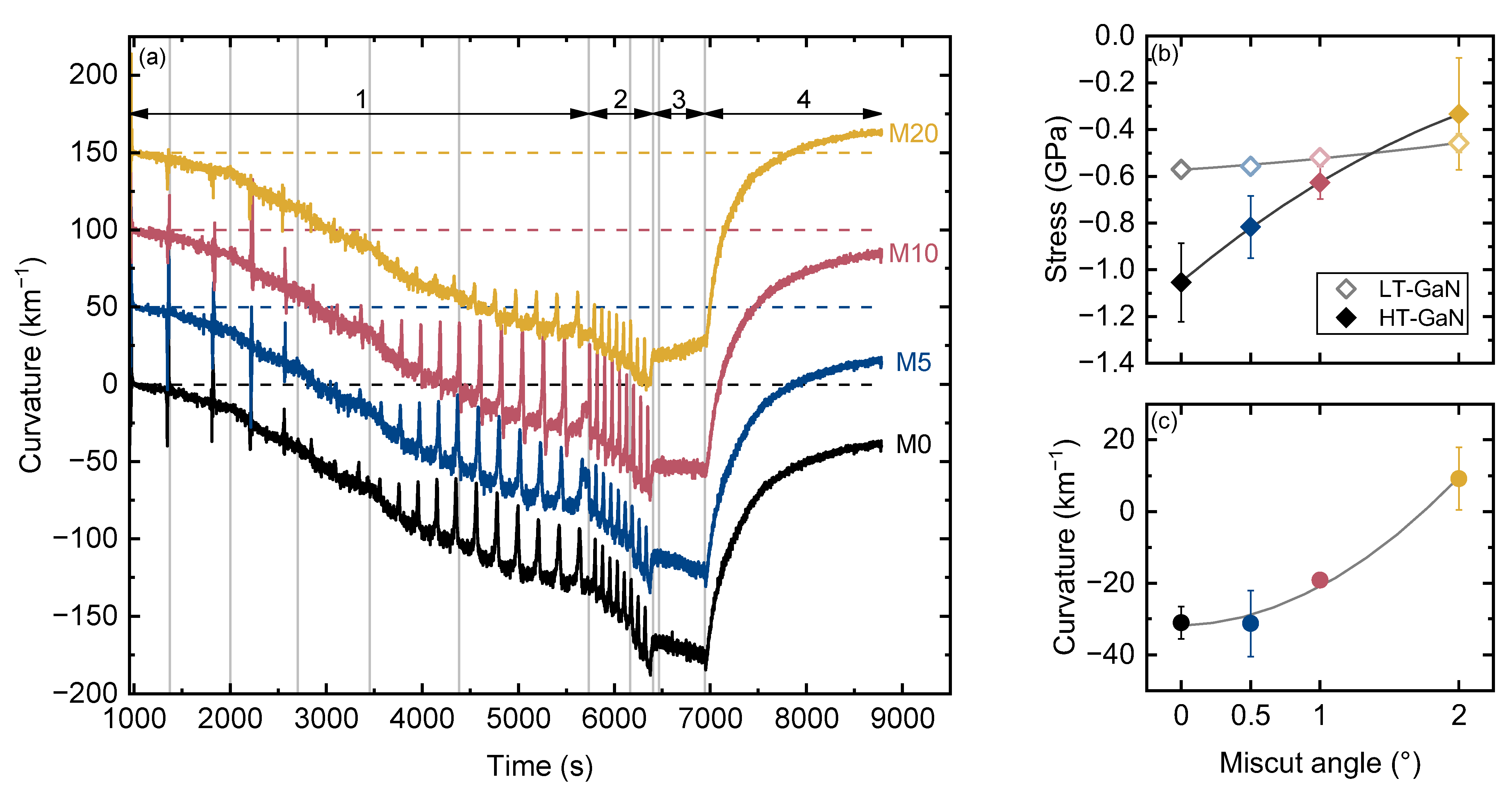
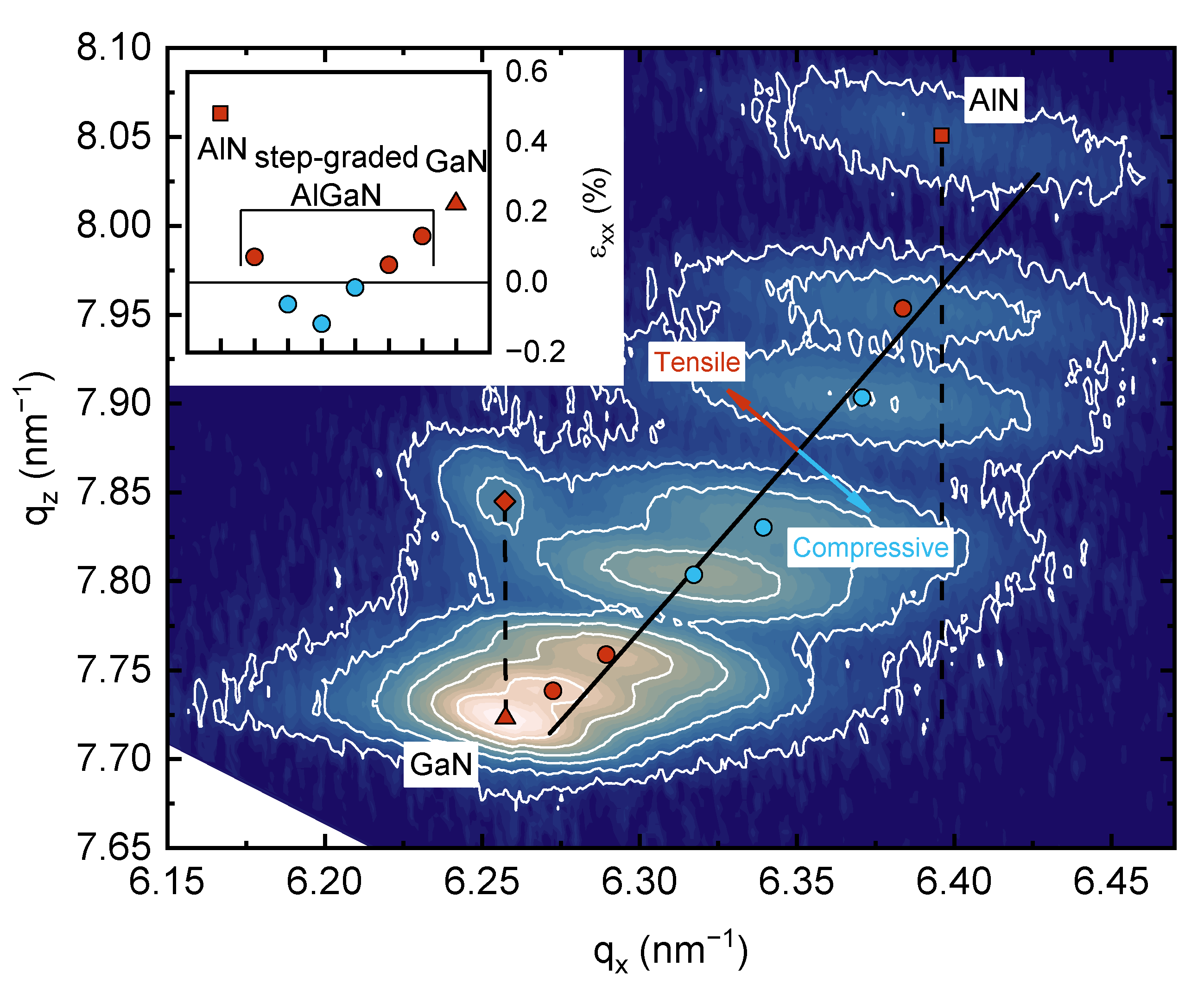

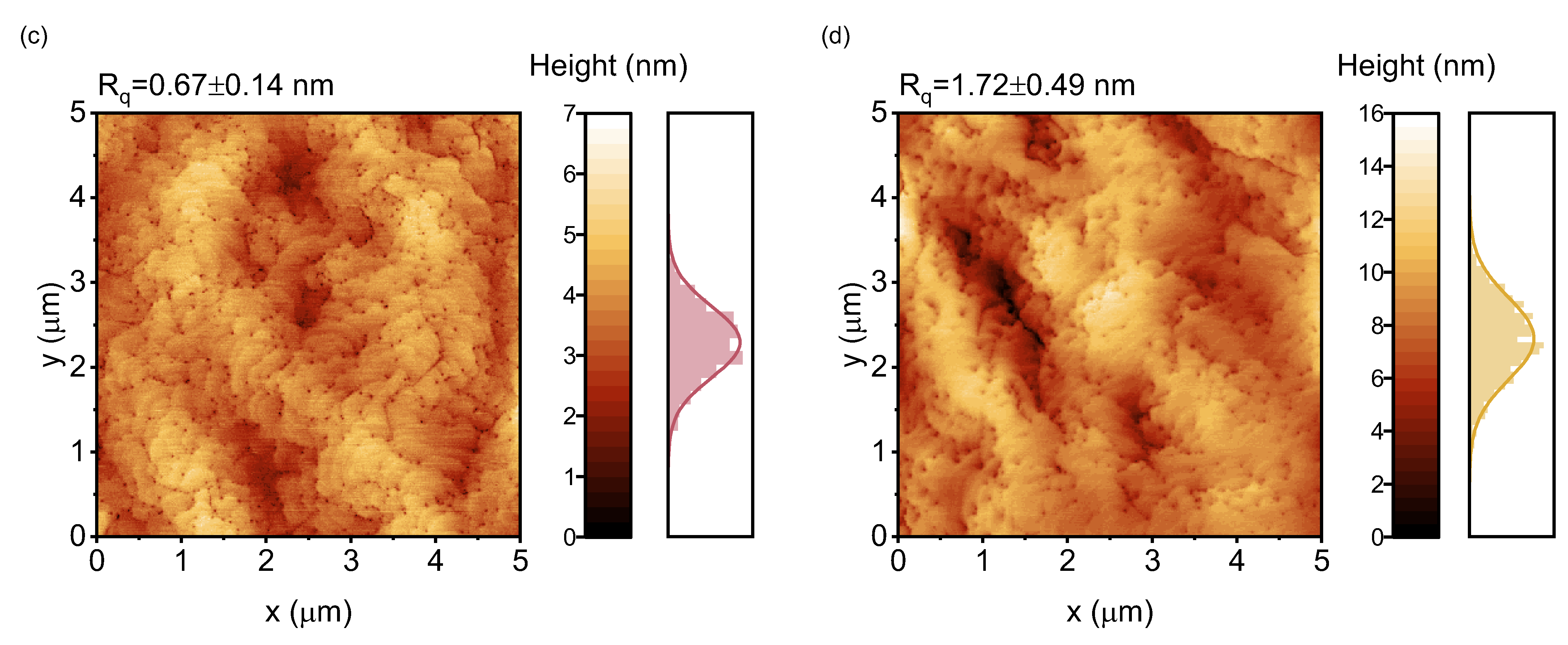
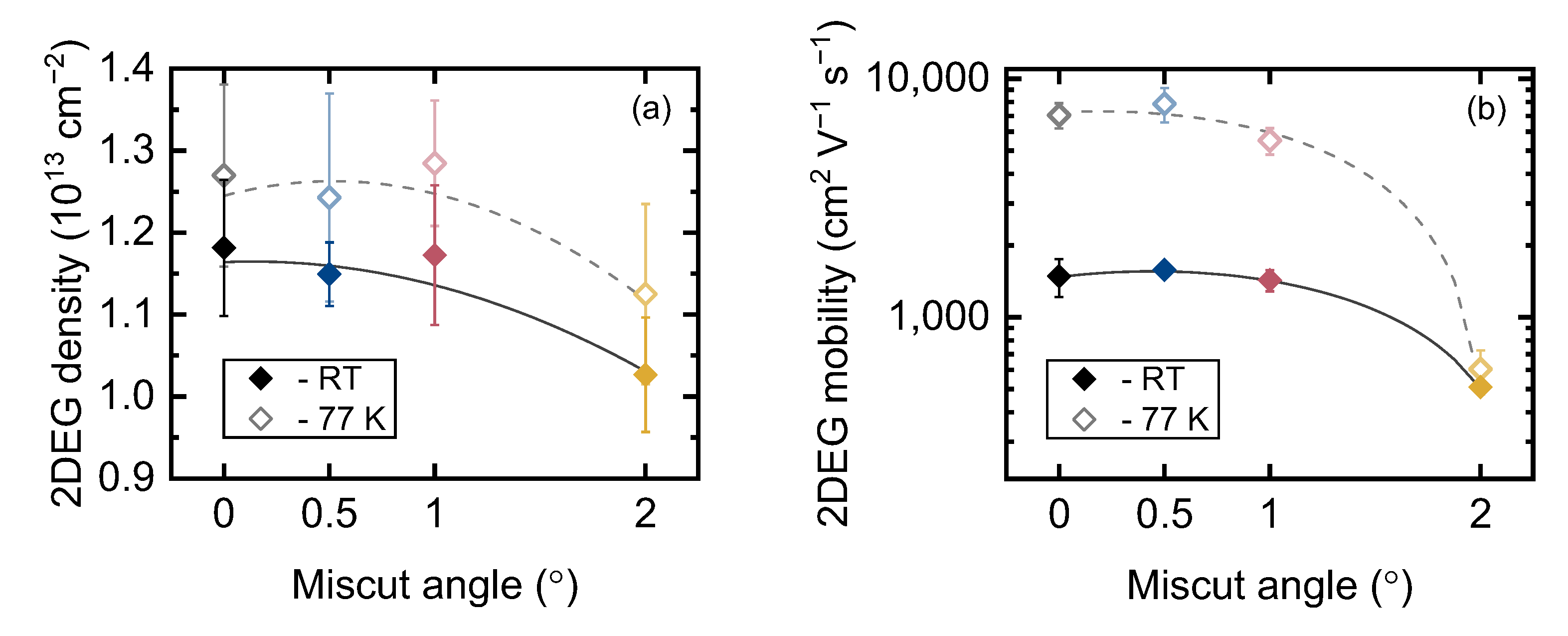
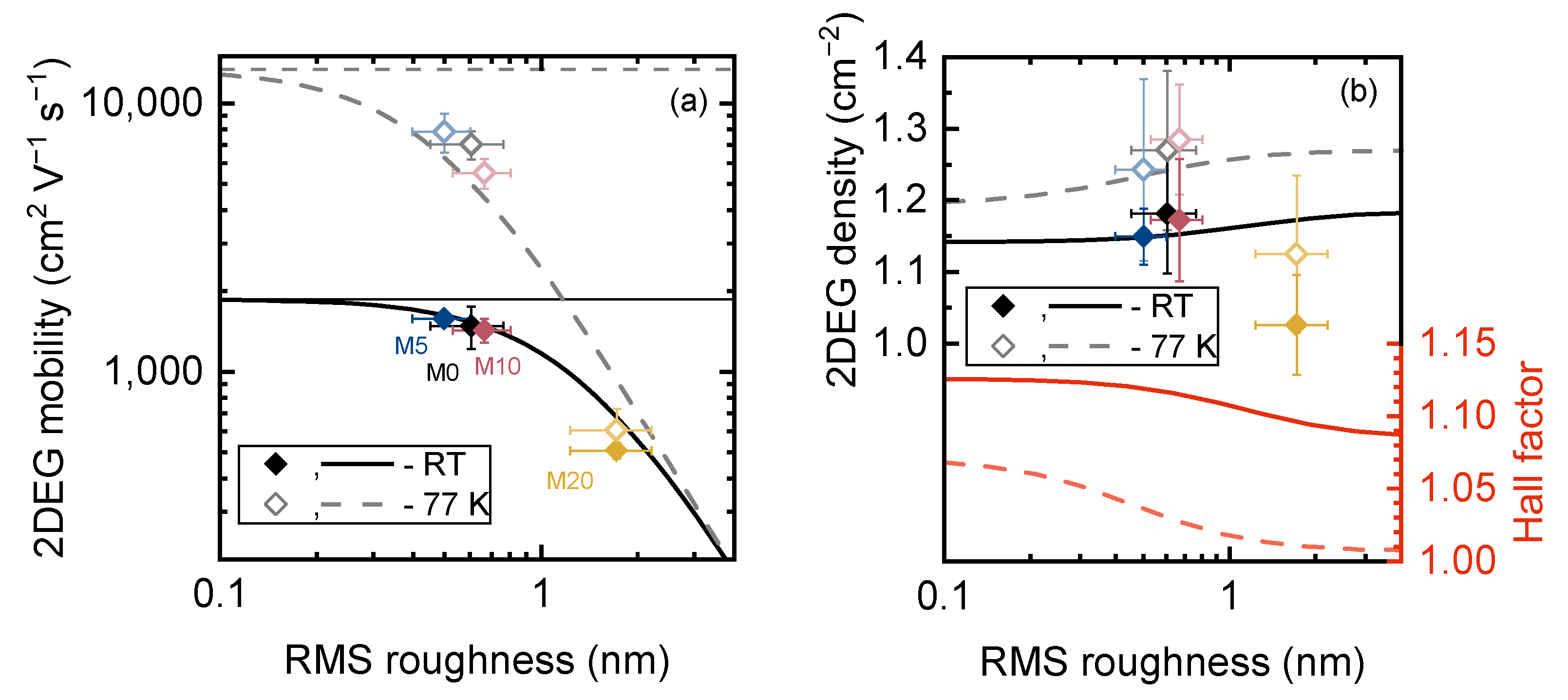
| Sample | Miscut Angle | Final Curvature, km−1 | Rq (5 × 5 μm), nm | TDD, 109 cm−2 | N2D (RT) 1013 cm−2 | μ2D (RT) cm2 V−1 s−1 | N2D (77 K) 1013 cm−2 | μ2D (77 K) cm2 V−1 s−1 |
|---|---|---|---|---|---|---|---|---|
| M0/A0 | <0.05° | −31 ± 4 | 0.61 ± 0.15 | 3.68 ± 0.31 | 1.18 ± 0.08 | 1485 ± 268 | 1.27 ± 0.11 | 7042 ± 847 |
| M5/A5 | 0.5° | −31 ± 9 | 0.50 ± 0.10 | 3.70 ± 0.34 | 1.15 ± 0.04 | 1580 ± 78 | 1.24 ± 0.13 | 7851 ± 1285 |
| M10/A10 | 1.0° | −19 ± 2 | 0.67 ± 0.14 | 3.57 ± 0.28 | 1.17 ± 0.09 | 1430 ± 145 | 1.28 ± 0.08 | 5508 ± 696 |
| M20/A20 | 2.0° | +9 ± 8 | 1.72 ± 0.49 | 2.55 ± 0.14 | 1.03 ± 0.07 | 510 ± 179 | 1.13 ± 0.11 | 606 ± 121 |
Disclaimer/Publisher’s Note: The statements, opinions and data contained in all publications are solely those of the individual author(s) and contributor(s) and not of MDPI and/or the editor(s). MDPI and/or the editor(s) disclaim responsibility for any injury to people or property resulting from any ideas, methods, instructions or products referred to in the content. |
© 2023 by the authors. Licensee MDPI, Basel, Switzerland. This article is an open access article distributed under the terms and conditions of the Creative Commons Attribution (CC BY) license (https://creativecommons.org/licenses/by/4.0/).
Share and Cite
Sakharov, A.V.; Arteev, D.S.; Zavarin, E.E.; Nikolaev, A.E.; Lundin, W.V.; Prasolov, N.D.; Yagovkina, M.A.; Tsatsulnikov, A.F.; Fedotov, S.D.; Sokolov, E.M.; et al. AlGaN HEMT Structures Grown on Miscut Si(111) Wafers. Materials 2023, 16, 4265. https://doi.org/10.3390/ma16124265
Sakharov AV, Arteev DS, Zavarin EE, Nikolaev AE, Lundin WV, Prasolov ND, Yagovkina MA, Tsatsulnikov AF, Fedotov SD, Sokolov EM, et al. AlGaN HEMT Structures Grown on Miscut Si(111) Wafers. Materials. 2023; 16(12):4265. https://doi.org/10.3390/ma16124265
Chicago/Turabian StyleSakharov, Alexei V., Dmitri S. Arteev, Evgenii E. Zavarin, Andrey E. Nikolaev, Wsevolod V. Lundin, Nikita D. Prasolov, Maria A. Yagovkina, Andrey F. Tsatsulnikov, Sergey D. Fedotov, Evgenii M. Sokolov, and et al. 2023. "AlGaN HEMT Structures Grown on Miscut Si(111) Wafers" Materials 16, no. 12: 4265. https://doi.org/10.3390/ma16124265
APA StyleSakharov, A. V., Arteev, D. S., Zavarin, E. E., Nikolaev, A. E., Lundin, W. V., Prasolov, N. D., Yagovkina, M. A., Tsatsulnikov, A. F., Fedotov, S. D., Sokolov, E. M., & Statsenko, V. N. (2023). AlGaN HEMT Structures Grown on Miscut Si(111) Wafers. Materials, 16(12), 4265. https://doi.org/10.3390/ma16124265







